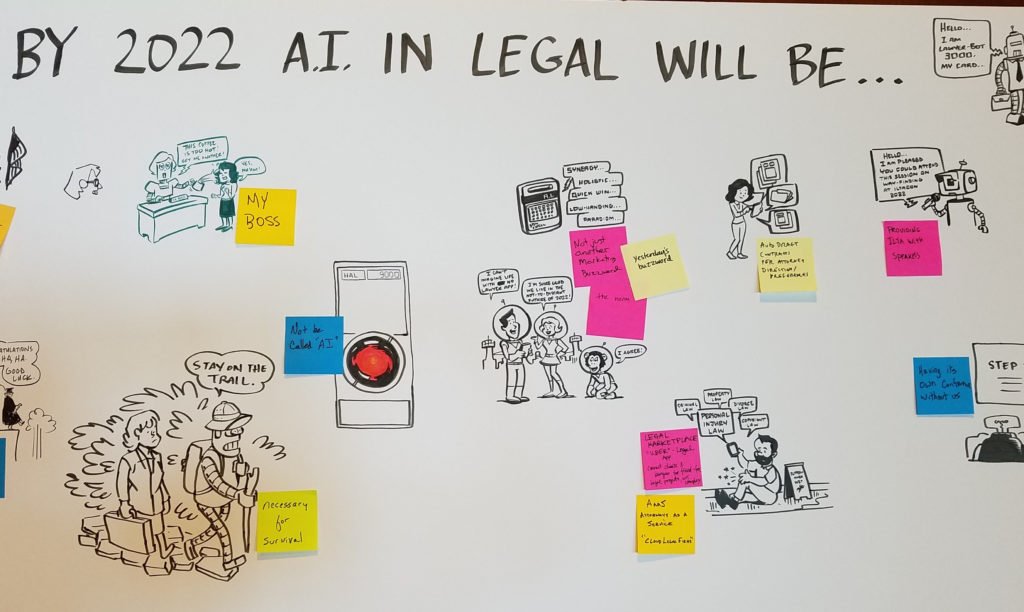
Artificial Lawyer’s great Guest Bloggers at ILTACon 2017 have continued their intrepid coverage of what’s going down in legal tech land.
Guest Bloggers, Alicia Ryan, who is a Knowledge Management Attorney at US law firm Fenwick & West; and Matthew Golab, who is legal Informatics Manager at Australian law firm Gilbert + Tobin, report here on Day Two of the biggest legal tech event in the USA.
ILTACON17 Day Two – All Dressed Up…
By Alicia Ryan
It’s 9:30 p.m. on the second full day of ILTACON, and while my coworkers are downstairs at the fancy dress dinner, I sit quietly in my room composing my thoughts on today’s key topics: Artificial Intelligence and Blockchain.
Rest assured, even if you have no idea what either of those terms mean, you are not (yet) missing the party. (Unlike your dear Guest Blogger:)
So, what’s the state of play with these two technology juggernauts? Allow me to set a metaphorical scene: Imagine yourself on a railway platform. You look up at the clock; it’s five minutes of twelve. A moment full of potential, full of portents. You hear a whistle blow. The train you can see rounding the bend is AI. Ready or not, it’s about to arrive.
Blockchain is more like the 4am. It’s coming, but you still have time to enjoy a beverage.
The AI Party
I attended three AI sessions today. The morning panel opened with a look at what surveys are telling us. According to the most recent data, only 7.5% of law firms have adopted an AI solution – but this comes with a tremendous caveat: In law firms of over 1,000 attorneys, the adoption rate exceeds 50%.
So, yes, the cool kids have already arrived, and the party is in full swing. But what are they doing?

Law firm answers to that ran the gamut from tools that read time entries and re-code them for different clients to budget forecasting tools to contract review/extraction tools.
IBM Watson for Legal showcased 3 separate products in the opening keynote – a tool for reviewing narrative time entries for clients to help them detect anomalies, a tool for reviewing work product to find better precedent, and another for reviewing personnel bios, profiles, and publications to ferret out expertise.
Notice how I repeated the word ‘tool’ in that previous paragraph? That wasn’t sloppy drafting. AI is a tool.
Let me say that again. AI is a tool. Tools help people solve problems.
What’s Your Problem?
Instead of asking what flavour of AI tool others are using, perhaps it is better to ask what problems they are solving with AI tools.
Answers to that question look something like this:
- Tasks are often incorrectly coded, and this makes budgeting more difficult and annoys clients.
- Existing task codes don’t meet the needs of particular clients.
- Attorneys are bad at forecasting what matters will cost and how long they will take.
- Contract review is sometimes perceived by clients as too costly or cost-prohibitive.
Are these problems you see in your firm?
If your answer is yes, (and, let’s be honest, it probably is) AI may be a tool you can use. It may be THE TOOL, or it may be just one of several worthy options.
‘AI’ is a hot buzzword, and it has tremendous potential to help lawyers do things better or faster or both, but like any tool, it’s not magic. It will take money, time, and effective change management to implement any solution like these.
One of the sessions I attended was a recap of the AI session I got shut out of yesterday, and one of the key points there was that most AI tools are not things you can use right out of the box. They often have to be trained, and that training takes time, effort, and patience. They are “not an easy button.”
So, by all means, leap onto the AI Express, but be sure to mind the gap.
Stay tuned: given the length of this post, I’ll leave blockchain for a full treatment later.

And now Matthew Golab
Today’s keynote session was by IBM Watson Legal (Brian Kuhn and Shawnna Hoffman) on cognitive computing.
As would be expected, they had quite an impressive presentation and make a convincing case for why you’d use AI. They trotted out the oncology/medical success stories, however they didn’t have many actual concrete legal examples (that is apart from Ross Intelligence, although they didn’t say that much about Ross).
They made a point of saying that you should think of AI as Augmented Intelligence rather than Artificial.
The next session was a recap of the AI myths session 1 that was so packed on day 1 and this was very well attended. Session 2, AI in Action, was a fascinating panel session by:
Neil Cameron (MD NCCG), Stephen Allen (Global Head of Legal Service Delivery, Hogan Lovells), Ron Friedmann (Consultant, Fireman & Company), Steven Harmon (VP and Deputy General Counsel, Cisco Systems Inc), Katie DeBord (Chief Innovation Officer, Bryan Cave LLP), and moderated by Andrew Arruda from Ross
Ron opened with a summary of a few different industry surveys (all surveys were either from 2015, 2016 or 2017) and it was interesting to see the changes in views of AI by the survey respondents during this fairly short period.

Next up was Katie who spoke about how their approach to AI is threefold (Understand; Experiment and Apply).
In Understand they have a two-fold approach to this being CT and PEG (statisticians and legal technologists – i.e. a law firm’s take on data scientists) and secondly with TechX which is a group of attorneys who experiment with the legal tech/AI solutions.
[We asked the question afterwards if these attorneys were given fee relief for this work, and it appears that they get fee credits – not clear if this means they get a break from billable targets].
They have been experimenting both internally and with almost the entire top shelf of AI products, such as Kira Systems, eBrevia, RAVN; Ross, Neota Logic and Lex Machina.
Katie also raised a valid point on tech fatigue and having to carefully judge when you can deploy a new technology.
In one of the ‘Apply’ examples, Katie mentioned that they had analysed matter classification and time entries, and observed that 5% of a certain type of litigation matter accounted for over 50% of overall portfolio cost. These were eventually streamlined and saved the client over 60% of costs.
Katie’s final points were excellent:
- Change is hard (but it’s worth it)
- Need to carve out time to focus
- Invest in process and content
- Capture and analyse data
- Be entrepreneurial (take risks and fail quickly)
- Don’t let perfect be the enemy of good
Next was Stephen Allen who had many pragmatic tips, such as utilising machine learning as a service and building it into what you do. He said that AI usage was at about 30-40% and growing, and that they’d been using this in the form of Predictive Coding for years.
Then it was Neil Cameron who opened with the observation that he did a dual law and computer science degree in 1974 and that everyone (all of his professors etc) though he was completely mad and that computers aren’t compatible with the law.
Matter fee forecasts are increasingly being required by the Courts [in the UK], and lawyers are incredibly bad at fee forecasts, and they suffer from many planning cognitive biases, and in particular they conflate costing and pricing and that they typically don’t learn from previous estimates vs actuals and how to improve future fee estimates.
Some astonishing stats were that pre-crisis firms operated at 80-85% realisation and that this is now nearer to 70%, which equates in a large firm to tens of millions of dollars, if not hundreds of millions in a firm over $1bn in revenue.
The final presenter was Steve Harmon. He was fairly pragmatic, and mentioned that their ROI on AI has been dramatic. He was also critical of the messaging around AI and that it is being oversold and over-hyped, and that lawyers are better than they think.

This was my top session to date and it was really excellent to get the cumulative experience from the panellists. One slightly disappointing aspect was that a lot of the pilots that had been run by the panellists were about time narratives and classifying matters and I guess optimising profitability. This is nice, however it would be good for the focus to pivot instead to real client problems rather than internally on law firm profitability.
I attended several other sessions that weren’t specifically AI related, and also ventured into the vendor hall which has about 300+ vendors all cheerfully wanting to engage with you and tell you how you’re missing out not using their products.
I was able to chat with Seal software who are another AI powered contract tool. In addition, I was able to catchup with Ringtail late yesterday, and had some terrific insights into the future development of the product and was speaking with Skip Walter who is quite an impressive person considering that he was largely the founder of Attenex which was brought into Ringtail more than a decade ago and powers a lot of the AI/analytics features.
Slightly over 15 km walked today – although to be fair about 9 of these were at the conference and the balance were related to some extra-curricular excursions afterwards…
1 Trackback / Pingback
Comments are closed.